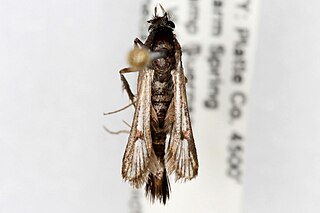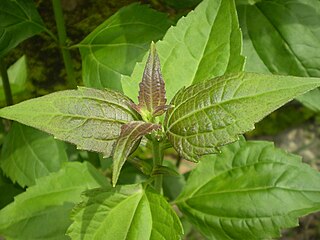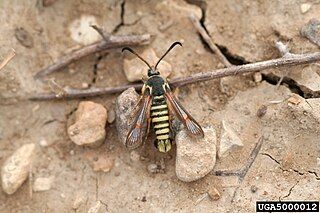
The Sesiidae or clearwing moths are a diurnal moth family in the order Lepidoptera known for their Batesian mimicry in both appearance and behaviour of various Hymenoptera.

Carmenta is a genus of moths in the family Sesiidae.

Chromolaena odorata is a tropical and subtropical species of flowering shrub in the family Asteraceae. It is native to the Americas, from Florida and Texas in the United States south through Mexico and the Caribbean to South America. It has been introduced to tropical Asia, West Africa, and parts of Australia.

Chromolaena is a genus of about 165 species of perennials and shrubs in the family Asteraceae. The name is derived from the Greek words χρῶμα (khrôma), meaning "color", and χλαῑνα (khlaīna) or λαῑνα (laīna) meaning "cloak". It refers to the colored phyllaries of some species. Members of the genus are native to the Americas, from the southern United States to South America. One species, Chromolaena odorata, has been introduced to many parts of the world where it is considered a weed.

Carmenta mimuli, the coronopus borer, is a moth of the family Sesiidae. The dark form is the typical form and is found in Arizona. The whitish form is non-typical and is known from the south-western United States, from Kansas to Arizona.
Carmenta engelhardti is a moth of the family Sesiidae. It was described by W. Donald Duckworth and Thomas Drake Eichlin in 1973. It is known from Arizona in the United States.
Carmenta welchelorum is a moth of the family Sesiidae. It was described by W. Donald Duckworth and Thomas Drake Eichlin in 1977. It is known from south-central Texas in the United States.
Carmenta wellerae is a moth of the family Sesiidae. It was described by W. Donald Duckworth and Thomas Drake Eichlin in 1976. It is known from southern Arizona in the US and northern Mexico. The habitat consists of mountains and foothills.
Carmenta haematica, the Argentine root borer, is a moth of the family Sesiidae. It was described by Ureta in 1956, and is known from Argentina and Chile.
Carmenta foraseminis is a moth of the family Sesiidae. It was described by Thomas Drake Eichlin in 1995, and is known from Panama, Colombia, Venezuela, and Brazil. The larva of the species have been found on plants of the species Gustavia angustifolia, Gustavia superba, as well as plants in the genus Eschweilera, and on the pods of Theobroma cacao.
Carmenta laurelae is a moth of the family Sesiidae. It was described by Larry N. Brown, Thomas D. Eichlin and J. Wendell Snow in 1985, and is known from the US state of Florida.
Carmenta flaschkai is a moth of the family Sesiidae. It was described by Eichlin in 1993. It is known from North America, including Texas.

Calephelis perditalis, also known as the rounded metalmark or lost metalmark, is a species of butterfly in the family Riodinidae. It is found in Texas in the United States and Mexico, south to Venezuela. The species was first described by William Barnes and James Halliday McDunnough in 1918.

Mikania natalensis, the Natal mikania, is a plant in the family Asteraceae, and is native to Africa.
Eucampyla is a monotypic snout moth genus. Its only species, Eucampyla etheiella, is known from Micronesia, the Society Islands and Australia. Both the genus and species were first described by Edward Meyrick in 1882.

Galtara extensa is a moth of the subfamily Arctiinae first described by Arthur Gardiner Butler in 1880. It is found on the Comoros and in Madagascar.

Actinote thalia is a butterfly of the family Nymphalidae. It was described by Carl Linnaeus in the 1758 10th edition of Systema Naturae. It is found in most of South America. An attempt was made by the South African programme to defoliate the Chromolaena odorata, a shrub of Neotropical origin, by this species, but was disqualified due to an unacceptably wide host range.

Pareuchaetes pseudoinsulata is a moth of the subfamily Arctiinae native to Venezuela and Trinidad and Tobago. It is an introduced species in Sri Lanka, as well as in Malaysia, Indonesia, the Philippines and Guam.
The following is a list of invasive alien species (IAS) in the Philippines. These species are regarded to have a negative effect on the local ecosystem and the economy, although not all species introduced from outside the archipelago are considered as "invasive".









